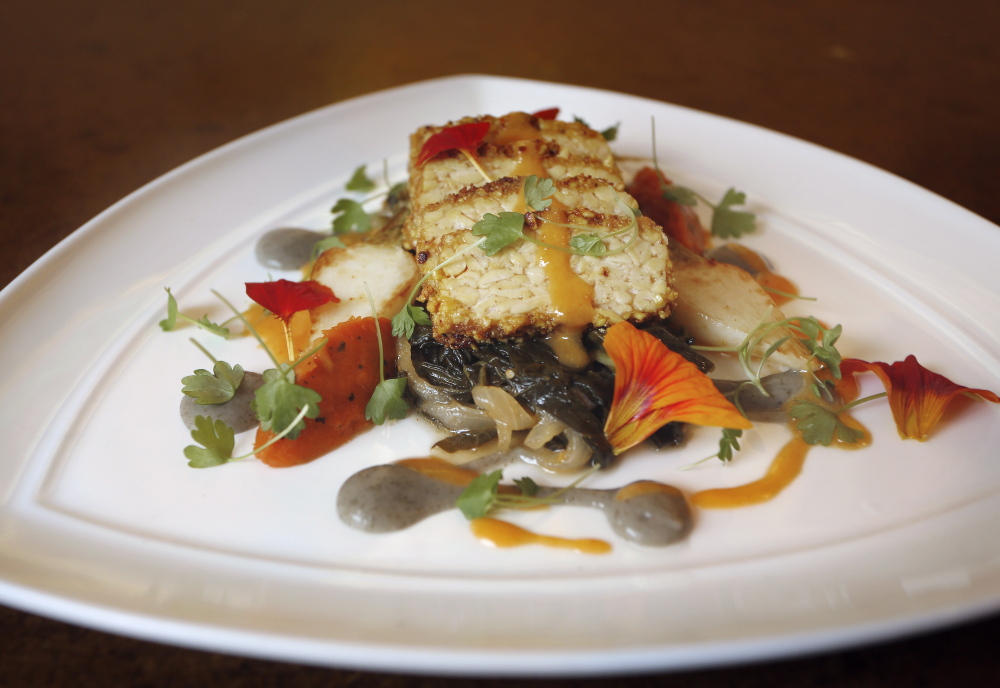Like many of us, Adam Flood is new to cooking tempeh.
Flood, the executive chef at Grace in downtown Portland, discovered tempeh, a fermented bean cake from Indonesia, a couple years ago but has only recently begun to explore it in depth in his kitchen. His curiosity was sparked after Ian Jerolmack of Stonecipher Farm in Bowdoinham gave him a sample of the small-batch tempeh produced at nearby Lalibela Farm. This fall, Grace’s signature vegan dish is marinated local tempeh, featuring both the soybean and the black bean tempehs from the artisanal Maine producer.
“I got the sample, and I played around with it and said, ‘This is really good,'” Flood recalls. “I’m using it because it’s different and not just tofu. I think it’s better than tofu.”
The menu describes the entrée as peanut-crusted soy tempeh paired with a puree of black bean tempeh and hijiki, a sea vegetable. It is served with braised collards, carrot marmalade and lime pickle, an Indian condiment.
“Tofu and tempeh are generally looked at as just for vegans,” Flood said. “But I see a lot of people ordering it, and they aren’t vegan, and they seem to enjoy it.”
Jaime Berhanu runs Lalibela Farm with her husband, Andy, and the couple sell their organic tempeh at the Portland Farmers’ Market and a number of area health food stores and local foods markets. Her experience is similar. “The people that buy from us are not necessarily all vegans or vegetarians,” said Berhanu, who is a vegetarian herself. “I appreciate that the tempeh can hold its own in a diet that includes meat as a protein.”
As the national trend spotters keep telling us, an ever-growing number of Americans are replacing some of their meat-based meals with vegetarian dishes.
For people new to tempeh, it can “seem so unusual,” Berhanu said, that they think to themselves, “‘What would you possibly do with it?'”
The answer is a lot.
“It can be really complicated to cook with,” she told me, “or it can be really simple and fast.”
VERSATILE PROTEIN
As a busy farmer, food producer and mother of two, Berhanu usually sticks with simple.
Her own introduction to tempeh came when she lived with a house full of farmworkers on an organic farm in Washington state, where they ordered their tempeh by the crate. A housemate taught her how to prepare it – cutting a block of tempeh in half, then slicing it lengthwise into a square patty or strips. Either way, she would brown the tempeh pieces in a hot skillet for 5 to 8 minutes per side, and when they were almost done, she’d splash on a bit of tamari. I gave this a try and was astonished by how much flavor this simple technique adds.
“I’d eat it on a green salad or a on a sandwich with a tahini-miso dressing,” Berhanu said. “That’s what I ate for lunch for years, and it’s still my go-to preparation. It’s really fast, really easy, really satisfying and a good shot of protein.”
A half-cup of tempeh packs 15 grams of protein and brims with other nutrients, including fiber, folate, calcium, magnesium and iron.
But pan-frying is just the start. Berhanu also marinates (the longer you do so, the stronger the flavor), grills, stir fries and bakes it (375 degrees F for 20 to 30 minutes). She uses tempeh to stuff vegetables – zucchini in the summer and winter squash in the fall – and she slow cooks it in stews.
MOVE OVER, CHICKEN
For almost a decade, Wild Oats Bakery & Cafe in Brunswick has offered a mock chicken salad made with tempeh.
“We started developing vegan recipes because a lot of our staff are vegan, and a lot of customers began asking for vegan products,” said Becky Shepherd, who with her husband, David, opened the Brunswick restaurant in 1991 in the Tontine Mall, within walking distance of Bowdoin College. They recently expanded to a second location at Brunswick Landing, the former Naval base.
The salad is made with crumbled Lalibela Farm soybean tempeh and vegan mayonnaise. As with ordinary chicken salad, it’s seasoned with chopped dill pickles, celery, onion and fresh parsley. “I was looking for something that had a nice texture,” Shepherd told me. “Tempeh is meatier than tofu, and we got a really good response to it.”
More recently, the café added a curried tempeh salad, made with apples, grated carrots, fresh parsley and a house-made curry blend. Before making the salad, they cook the tempeh, blanching it for about 15 minutes or steaming it for about 20. Then “your two key things are you have to have it well drained and chilled,” Shepherd said.
Whatever you plan to make, Berhanu recommends steaming all tempeh for a few minutes before using it. This is particularly important if you plan to use a marinade, as steaming “makes it more receptive to absorbing flavors and liquids,” she said.
Unlike the national brand tempehs you can buy at the grocery store, Lalibela Farm tempeh isn’t pasteurized. Because of this it can’t be eaten raw. Lalibela tempeh is sold frozen, and Berhanu advises customers to steam the frozen tempeh, unwrapped, for a couple minutes to thaw.
DON’T TRY THIS AT HOME
While Berhanu knows how to get a tempeh-centric meal on the table quickly, back at Grace, chef Flood makes a complicated preparation suited to an elegant restaurant, that requires marinating, braising, coating, pan-frying and baking. And he still has to make the sauce. For that, Flood and his team dice the black bean tempeh and cook it with sake, soy sauce and hijiki, then puree the mixture and add it to the plate with the braised greens and condiments. While Flood deploys all his culinary know-how to create the multifaceted tempeh dish on Grace’s menu, home cooks can find success sticking to the basics, he said.
“Marinate and fry it would be the easiest way to go about it,” Flood said, adding that lightly coating the tempeh with rice flour or cornstarch before frying it will help it brown and crisp.
Tempeh works well with a range of flavors from teriyaki to chimichurri, Berhanu said. Flood agrees, adding that even unexpected flavors can work.
“I think you could even go and soak it in buttermilk and Frank’s Red Hot,” Flood said. “I would never put that on our menu, but it would be good.”
AVERY’S SMOKY TEMPEH STRIPS
I like this smoky tempeh as a cruelty-free substitute for bacon. It works well on sandwiches, salads and pizzas. It also makes a nice savory breakfast side.
Makes enough for 2 sandwiches
8 ounces tempeh, cut into thin strips
1/3 cup tamari
1/4 cup maple syrup
2 tablespoons apple cider vinegar
1 teaspoon liquid smoke
1½ teaspoons garlic powder
1 teaspoon onion powder or flakes
Freshly ground black pepper to taste
Expeller-pressed vegetable oil, for frying
Remove tempeh from package and steam over simmering water for 10 to 15 minutes in a steamer basket.
Mix together the tamari, maple syrup, vinegar, liquid smoke, garlic powder, onion powder and black pepper. Add the tempeh strips to a large, flat-bottom dish (or dishes) that can accommodate all the tempeh strips in a single layer. Pour the marinade over the tempeh strips. Marinate in refrigerator overnight or up to one week.
When you are ready to cook, lightly oil a cast iron frying pan or griddle and place over medium high heat. Add the strips to the hot surface and cook, flipping carefully with a fork, until browned on both sides, about 5 minutes per side.
VARIATION: If using it as a topping for pizza or salad, crumble the tempeh on the frying pan and stir with a spatula rather than using a fork to flip each piece.
Avery Yale Kamila is a freelance food writer who lives in Portland. She can be contacted at:
avery.kamila@gmail.com
Twitter: AveryYaleKamila
Send questions/comments to the editors.




